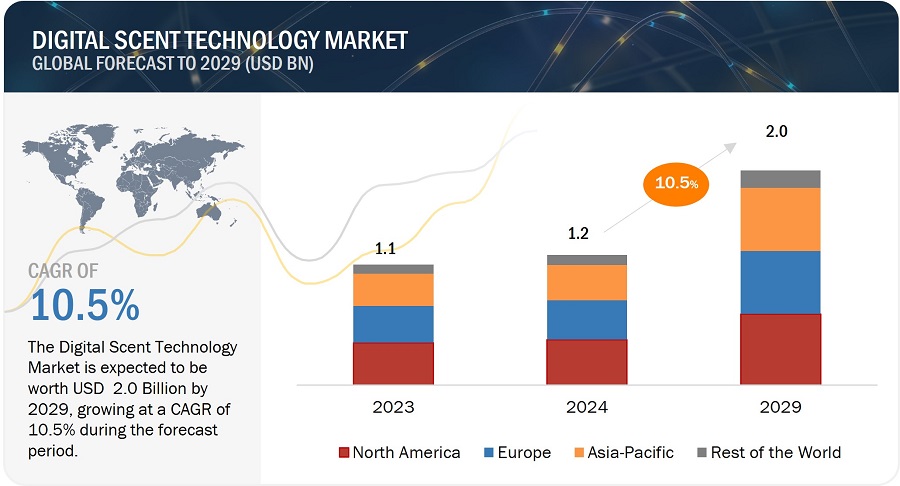The report “Digital Scent Technology Market by Hardware Device (E-Nose, Scent Synthesizers), End-Use Product (Medical Diagnostic Products, Quality Control Products), Application (Medical, Food & Beverages, Military & Defense) and Region – Global Forecast to 2029” The Digital Scent Technology industry size is projected to grow from USD 1.2 billion in 2024 and is estimated to reach USD 2.0 billion by 2029; it is expected to grow at a Compound Annual Growth Rate (CAGR) of 10.5% from 2024 to 2029.
The Digital Scent Technology industry growth is driven by the growing adoption of e-noses in food industry for process monitoring, freshness evaluation, and authenticity assessment; increasing adoption of compact, portable, and IoT-enabled e-noses.
Download PDF Brochure @ https://www.marketsandmarkets.com/pdfdownloadNew.asp?id=118670062
Browse 180 market data Tables and 63 Figures spread through 277 Pages and in-depth TOC on “Digital Scent Technology Market by Hardware Device (E-Nose, Scent Synthesizers), End-Use Product (Medical Diagnostic Products, Quality Control Products), Application (Medical, Food & Beverages, Military & Defense) and Region – Global Forecast to 2029”
View detailed Table of Content here – https://www.marketsandmarkets.com/Market-Reports/digital-scent-technology-market-118670062.html
By hardware device, the e-noses are projected to grow at a high CAGR of digital scent technology industry during the forecast period.
Electronic sensors for odor detection encompass diverse technologies, including polymer sensors, quartz crystal microbalance (QCM) sensors, and metal-oxide-semiconductor field-effect transistors (MOSFET) sensors. Polymer sensors create an odor “fingerprint by leveraging polymer film conductivity changes. QCM sensors use piezoelectric quartz crystals to detect frequency alterations caused by odor molecules. With rapid response times, MOSFET sensors measure metal oxide layer conductivity changes. Advantages include objectivity, sensitivity, selectivity, and miniaturization. Microprocessors process sensor data, performing tasks like signal conditioning and feature extraction. Neural networks enhance pattern recognition, enabling odor classification, component identification, and concentration quantification. This integrated technology holds promise for applications like food quality control, environmental monitoring, medical diagnosis, and security.
By segment, Medical diagnostic products in end-use product segment in digital scent technology industry is expected to account for the largest share during the forecast period.
Electronic noses, or e-noses, emulate the human sense of smell through gas sensors that detect volatile organic compounds (VOCs) in breath or other samples. Particularly promising in respiratory diseases, e-nose testing offers a non-invasive, painless, and cost-effective approach to detection. Capable of identifying unique biomarkers, e-noses facilitate early diagnosis by detecting subtle changes in VOC profiles before symptoms manifest. Their quick and easy application makes them suitable for point-of-care settings. For instance, in February 2023, a research team at AIIMS (India) developed an electronic nose (e-nose) for the early detection of lung cancer. The breath print device analyzed volatile organic compounds in exhaled breath, offering a non-invasive method for identifying the disease. The innovation aimed to facilitate early detection, particularly in developing countries like India, where late-stage diagnoses are common. While still in development, ongoing research explores their potential in diseases like asthma, chronic obstructive pulmonary disease (COPD), lung cancer, and tuberculosis, indicating a transformative role for e-noses in revolutionizing respiratory disease diagnosis and management.
By application, Medical segment in digital scent technology industry will account for largest share during the forecast period.
The emergence of electronic nose (e-nose) technology is revolutionizing lung cancer diagnostics by offering a non-invasive and rapid solution. Utilizing sensor arrays to detect unique volatile organic compounds (VOCs) associated with the disease, e-nose technology provides a breakthrough in early-stage detection, surpassing traditional invasive methods. This innovation enhances the prospects of successful treatment by identifying lung cancer at earlier stages and reduces the overall healthcare burden associated with advanced-stage care. Integrating e-nose technology into diagnostic protocols signifies a notable shift toward more efficient and patient-friendly approaches, ultimately contributing to improved healthcare outcomes in lung cancer management.
By region, digital scent technology industry in Asia Pacific will account for the highest CAGR during the forecast period.
The region is emerging as a pivotal force in the global Digital Scent Technology market, poised for rapid growth in the coming years. China dominates with the largest market share among the regional leaders, driven by its vast population, technological advancements, and a surging demand for innovative solutions. India is experiencing the fastest growth, fueled by rising disposable incomes, increasing awareness of scent marketing, and government initiatives supporting startups. Further, Japan leads in technological innovation, exemplified by companies like Aromajoin (Japan), which offers advanced scent delivery systems. Key drivers include the surge in disposable incomes, the recognition of scent marketing’s impact on consumer behavior, and ongoing technological advancements in microfluidics, sensor technology, and artificial intelligence. The region’s growing urbanization further creates opportunities for targeted scent applications in retail, hospitality, and entertainment sectors. The Asia Pacific region is strategically positioned to capture a substantial share of the global digital scent technology industry, leveraging its large population, dynamic economies, and commitment to innovation.
Key companies operating in the Digital Scent Technology industry are Siemens (Germany), Amphenol Corporation (US), Sensirion AG (Switzerland), Honeywell International Inc. (US), Renesas Electronics Corporation (Japan), Envirosuite Ltd (Australia), Alpha MOS (France), Electronic Sensor Technology (US), Aromajoin Corporation (Japan), Figaro Engineering Inc. (US), Bosch Sensortec GmbH (Germany), and Alphasense (UK) among others.
Media Contact
Company Name: MarketsandMarkets™ Research Private Ltd.
Contact Person: Mr. Aashish Mehra
Email: Send Email
Phone: 18886006441
Address:630 Dundee Road Suite 430
City: Northbrook
State: IL 60062
Country: United States
Website: https://www.marketsandmarkets.com/Market-Reports/digital-scent-technology-market-118670062.html


